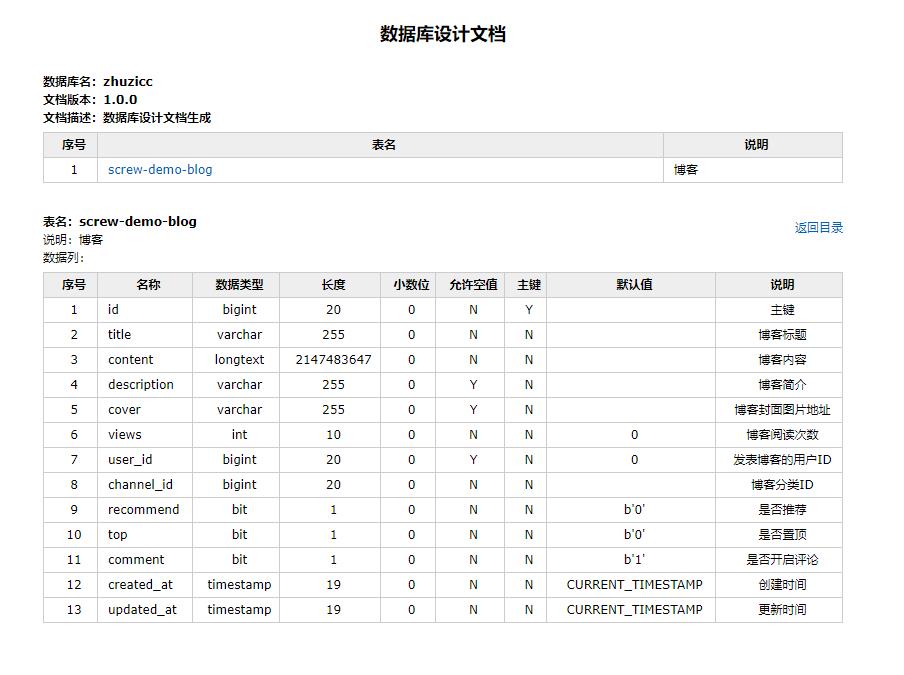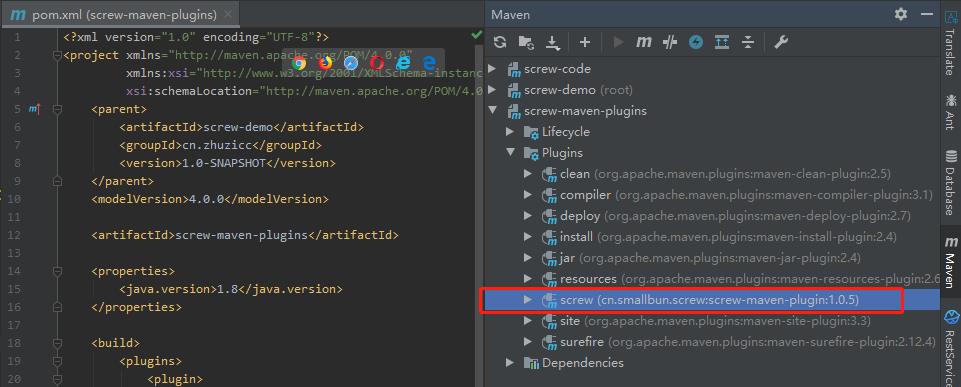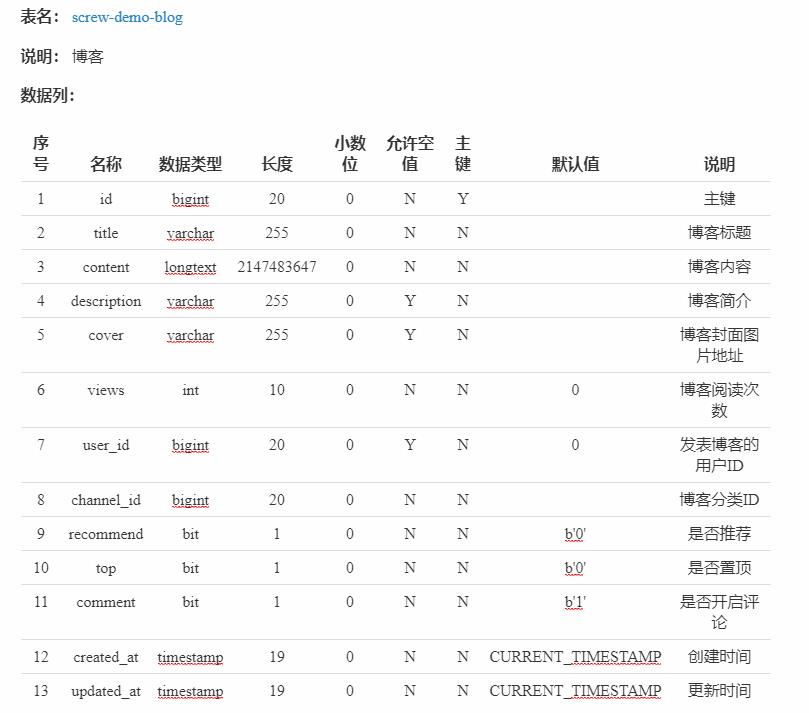Github上一款一键生成数据库文档的大利器!
Posted zhuzicc
tags:
篇首语:本文由小常识网(cha138.com)小编为大家整理,主要介绍了Github上一款一键生成数据库文档的大利器!相关的知识,希望对你有一定的参考价值。
介绍
今天看了 Guide老哥 公众号(需要的朋友可以关注一波: JavaGuide)中的一篇文章,发现了一款好用的数据库文档生成工具。
在项目中开发中,有没有遇到过编写数据库说明文档。一般情况下,数据库说明文档中有着大量的数据库表结构,如果手动进行维护,将会耗费大量时间,这样就不能愉快的进行摸鱼了。
所以呢,为了解决这个问题,Github 上的大佬开源了一款数据库表结构文档自动生成工具 —— screw

screw项目地址:https://github.com/pingfangushi/screw 。
screw 翻译过来的意思就是螺丝钉,作者希望这个工具能够像螺丝钉一样切实地帮助到我们的开发工作。
目前的话,screw 已经支持市面上大部分常见的数据库比如 mysql、MariaDB、Oracle、SqlServer、PostgreSQL、TiDB。
快速开始
表结构脚本
为了验证 screw 自动生成数据库表结构文档的效果,我们首先创建一个简单的存放博客数据的数据库表。
CREATE TABLE `screw-demo-blog` (
`id` bigint(20) NOT NULL AUTO_INCREMENT COMMENT '主键',
`title` varchar(255) NOT NULL COMMENT '博客标题',
`content` longtext NOT NULL COMMENT '博客内容',
`description` varchar(255) DEFAULT NULL COMMENT '博客简介',
`cover` varchar(255) DEFAULT NULL COMMENT '博客封面图片地址',
`views` int(11) NOT NULL DEFAULT '0' COMMENT '博客阅读次数',
`user_id` bigint(20) DEFAULT '0' COMMENT '发表博客的用户ID',
`channel_id` bigint(20) NOT NULL COMMENT '博客分类ID',
`recommend` bit(1) NOT NULL DEFAULT b'0' COMMENT '是否推荐',
`top` bit(1) NOT NULL DEFAULT b'0' COMMENT '是否置顶',
`comment` bit(1) NOT NULL DEFAULT b'1' COMMENT '是否开启评论',
`created_at` timestamp NOT NULL DEFAULT CURRENT_TIMESTAMP COMMENT '创建时间',
`updated_at` timestamp NOT NULL DEFAULT CURRENT_TIMESTAMP COMMENT '更新时间',
PRIMARY KEY (`id`)
) ENGINE=InnoDB AUTO_INCREMENT=16 DEFAULT CHARSET=utf8mb4 COMMENT='博客';
基于 Java 代码
引入 screw 及相关依赖
创建一个普通的maven项目,导入以下依赖
<!--screw-->
<dependency>
<groupId>cn.smallbun.screw</groupId>
<artifactId>screw-core</artifactId>
<version>1.0.5</version>
</dependency>
<!-- HikariCP -->
<dependency>
<groupId>com.zaxxer</groupId>
<artifactId>HikariCP</artifactId>
<version>3.4.5</version>
</dependency>
<!--MySQL-->
<dependency>
<groupId>mysql</groupId>
<artifactId>mysql-connector-java</artifactId>
<version>8.0.20</version>
</dependency>
你可以通过下面的地址在 mvnrepository 获取最新版本的 screw。
https://mvnrepository.com/artifact/cn.smallbun.screw/screw-core
代码编写
生成数据库文档的代码的整个代码逻辑还是比较简单的,我们只需要经过下面 5 步即可:
1、获取数据库源
/**
* 获取数据库源
*/
private static DataSource getDataSource() {
//数据源
HikariConfig hikariConfig = new HikariConfig();
hikariConfig.setDriverClassName("com.mysql.cj.jdbc.Driver");
hikariConfig.setJdbcUrl("jdbc:mysql://127.0.0.1:3306/test");
hikariConfig.setUsername("root");
hikariConfig.setPassword("root");
//设置可以获取tables remarks信息
hikariConfig.addDataSourceProperty("useInformationSchema", "true");
hikariConfig.setMinimumIdle(2);
hikariConfig.setMaximumPoolSize(5);
return new HikariDataSource(hikariConfig);
}
2、获取文件生成配置
/**
* 获取文件生成配置
*/
private static EngineConfig getEngineConfig() {
//生成配置
return EngineConfig.builder()
//生成文件路径
.fileOutputDir("/Users/guide/Documents/代码示例/screw-demo/doc")
//打开目录
.openOutputDir(true)
//文件类型
.fileType(EngineFileType.html)
//生成模板实现
.produceType(EngineTemplateType.freemarker)
//自定义文件名称
.fileName("数据库结构文档").build();
}
注意,如果不配置生成文件路径的话,默认也会存放在项目的 doc 目录下。
另外,我们这里指定生成的文件格式为 HTML。除了 HTML 之外,screw 还支持 Word 、Markdown 这两种文件格式。
3、获取数据库表的处理配置
可以在这里指定只生成哪些表结构(这个是可选项)
/**
* 获取数据库表的处理配置,可忽略
*/
private static ProcessConfig getProcessConfig() {
return ProcessConfig.builder()
// 指定只生成 blog 表
.designatedTableName(new ArrayList<>(Collections.singletonList("screw-demo-blog")))
.build();
}
这里进行设置需要忽略生成的表结构(这个也是可选项)
private static ProcessConfig getProcessConfig() {
ArrayList<String> ignoreTableName = new ArrayList<>();
ignoreTableName.add("test_user");
ignoreTableName.add("test_group");
ArrayList<String> ignorePrefix = new ArrayList<>();
ignorePrefix.add("test_");
ArrayList<String> ignoreSuffix = new ArrayList<>();
ignoreSuffix.add("_test");
return ProcessConfig.builder()
//忽略表名
.ignoreTableName(ignoreTableName)
//忽略表前缀
.ignoreTablePrefix(ignorePrefix)
//忽略表后缀
.ignoreTableSuffix(ignoreSuffix)
.build();
}
如果以上设置都没有注定 ProcessConfig 进行配置的话,就会按照默认配置来!
4、生成 screw 完整配置
private static Configuration getScrewConfig(DataSource dataSource, EngineConfig engineConfig, ProcessConfig processConfig) {
return Configuration.builder()
//版本
.version("1.0.0")
//描述
.description("数据库设计文档生成")
//数据源
.dataSource(dataSource)
//生成配置
.engineConfig(engineConfig)
//生成配置
.produceConfig(processConfig)
.build();
}
5、调用执行
private static Configuration getScrewConfig(DataSource dataSource, EngineConfig engineConfig, ProcessConfig processConfig) {
return Configuration.builder()
//版本
.version("1.0.0")
//描述
.description("数据库设计文档生成")
//数据源
.dataSource(dataSource)
//生成配置
.engineConfig(engineConfig)
//生成配置
.produceConfig(processConfig)
.build();
}
生成结果效果展示(.html):

基于 Maven 插件
除了基于 Java 代码这种方式之外,你还可以通过 screw 提供的 Maven 插件来生成数据库文档。个人感觉maven插件的方式更加简单!
引入screw及相关依赖
这一步操作还是一样,保持不变
<!--screw-->
<dependency>
<groupId>cn.smallbun.screw</groupId>
<artifactId>screw-core</artifactId>
<version>1.0.5</version>
</dependency>
<!-- HikariCP -->
<dependency>
<groupId>com.zaxxer</groupId>
<artifactId>HikariCP</artifactId>
<version>3.4.5</version>
</dependency>
<!--MySQL-->
<dependency>
<groupId>mysql</groupId>
<artifactId>mysql-connector-java</artifactId>
<version>8.0.20</version>
</dependency>
配置maven-plugins
这里还是在以上的依赖 pom.xml 文件中进行配置:
<build>
<plugins>
<plugin>
<groupId>cn.smallbun.screw</groupId>
<artifactId>screw-maven-plugin</artifactId>
<version>1.0.5</version>
<dependencies>
<!-- HikariCP -->
<dependency>
<groupId>com.zaxxer</groupId>
<artifactId>HikariCP</artifactId>
<version>3.4.5</version>
</dependency>
<!--mysql driver-->
<dependency>
<groupId>mysql</groupId>
<artifactId>mysql-connector-java</artifactId>
<version>8.0.20</version>
</dependency>
</dependencies>
<configuration>
<!--username-->
<username>root</username>
<!--password-->
<password>root</password>
<!--driver-->
<driverClassName>com.mysql.cj.jdbc.Driver</driverClassName>
<!--jdbc url-->
<jdbcUrl>jdbc:mysql://127.0.0.1:3306/test</jdbcUrl>
<!--生成文件类型-->
<fileType>MD</fileType>
<!--打开文件输出目录-->
<openOutputDir>true</openOutputDir>
<!--生成模板-->
<produceType>freemarker</produceType>
<!--文档名称 为空时:将采用[数据库名称-描述-版本号]作为文档名称-->
<fileName>数据库结构文档</fileName>
<!--描述-->
<description>数据库设计文档生成</description>
<!--版本-->
<version>${project.version}</version>
<!--标题-->
<title>数据库文档</title>
</configuration>
<executions>
<execution>
<phase>compile</phase>
<goals>
<goal>run</goal>
</goals>
</execution>
</executions>
</plugin>
</plugins>
</build>
手动执行生成数据库文档

生成结果效果展示(.md):

成品地址
这里呢,我已经把以上的示例代码上传到我码云仓库中,需要的朋友直接clone下来就可以运行使用。
本博客示例代码获取地址:https://gitee.com/zhuziccEE/screw-code.git
如果感觉文章对你有帮助,就给点个赞吧!
以上是关于Github上一款一键生成数据库文档的大利器!的主要内容,如果未能解决你的问题,请参考以下文章